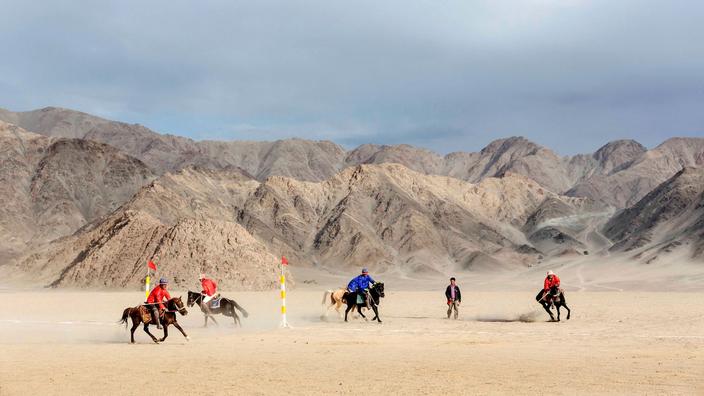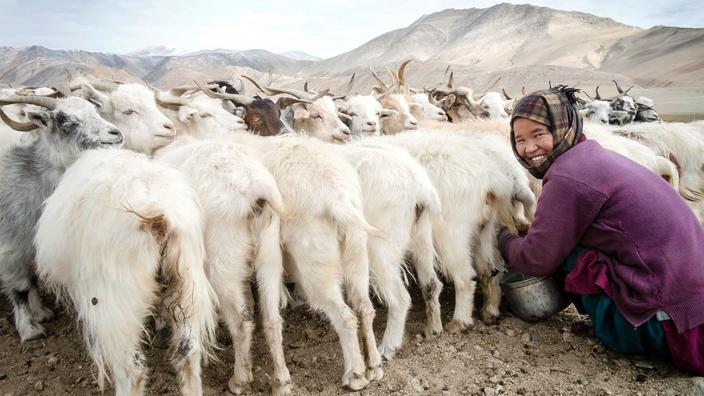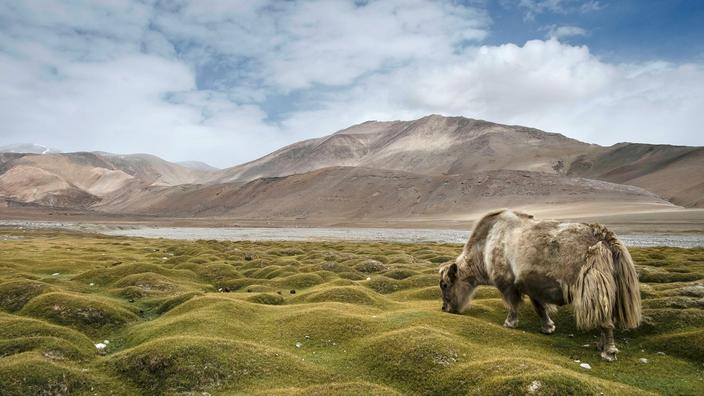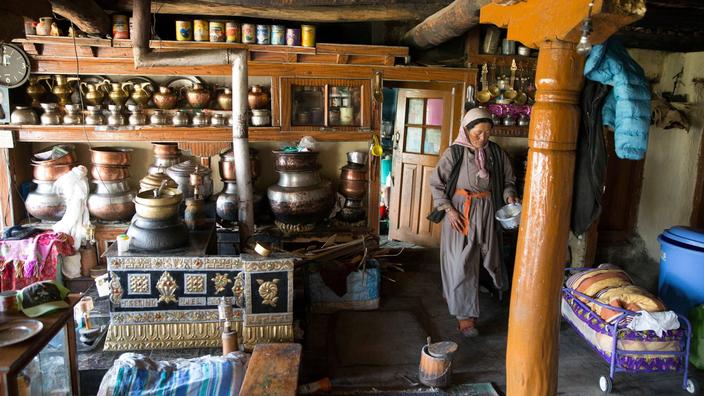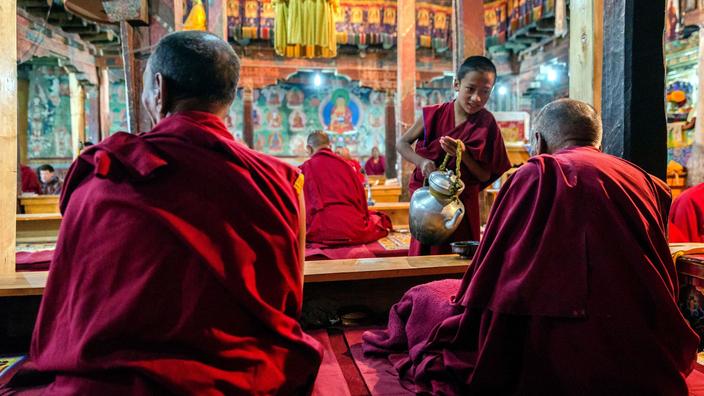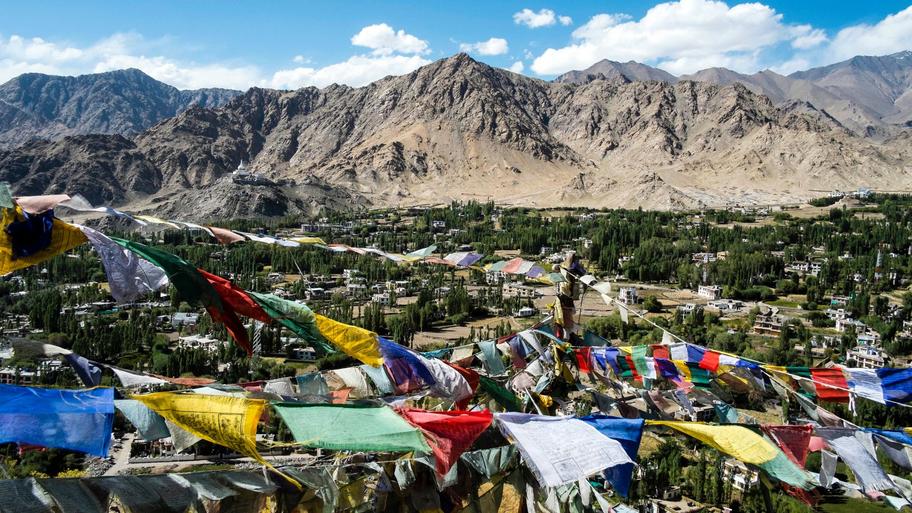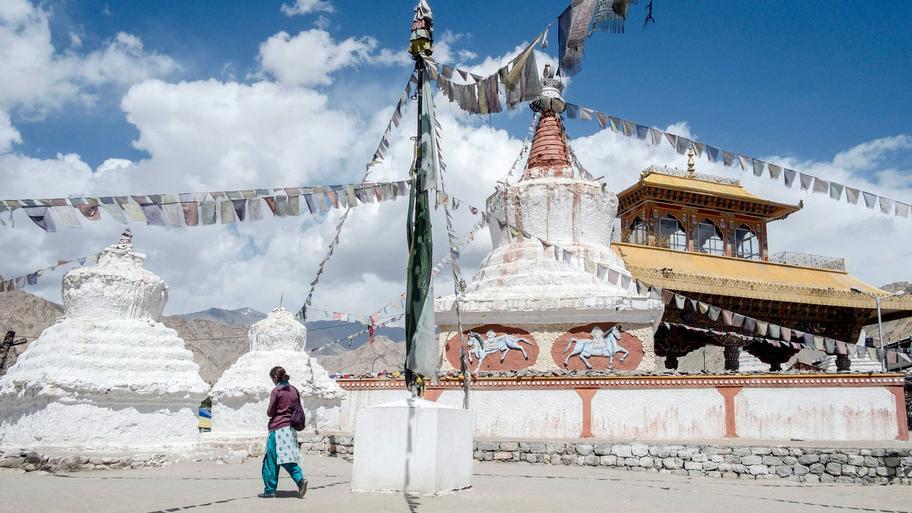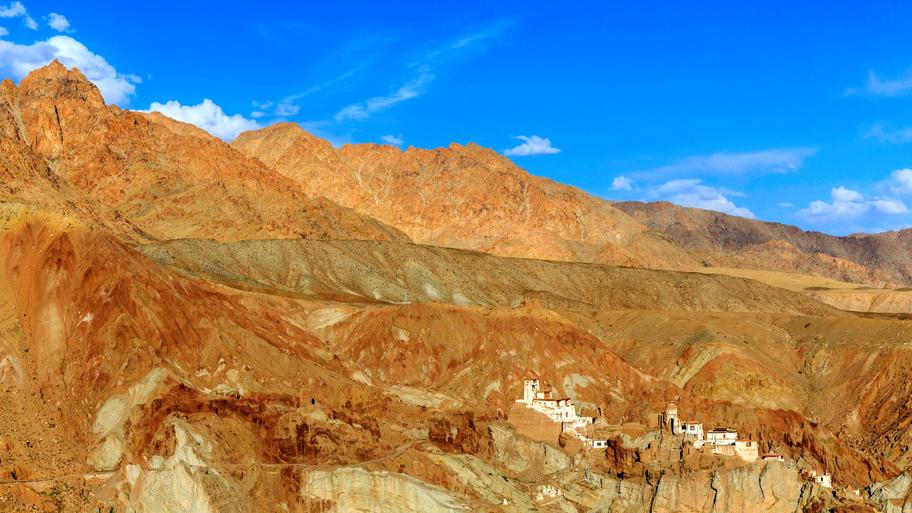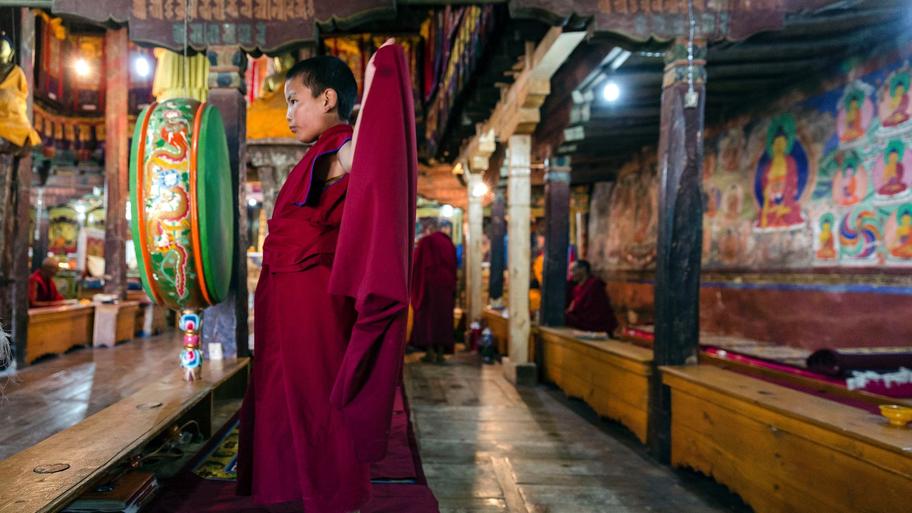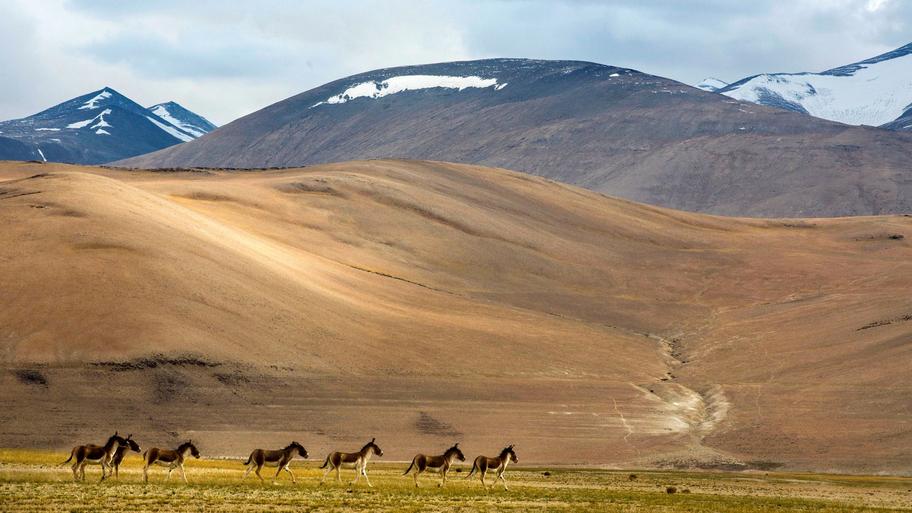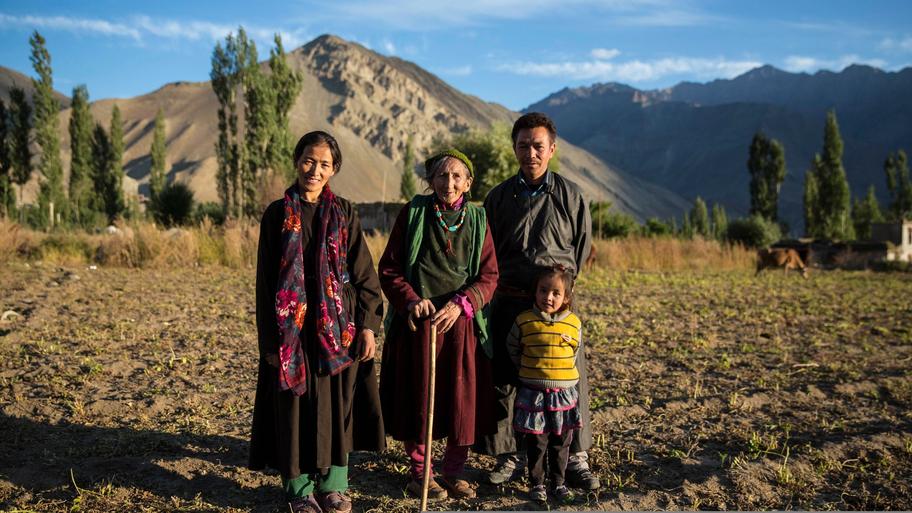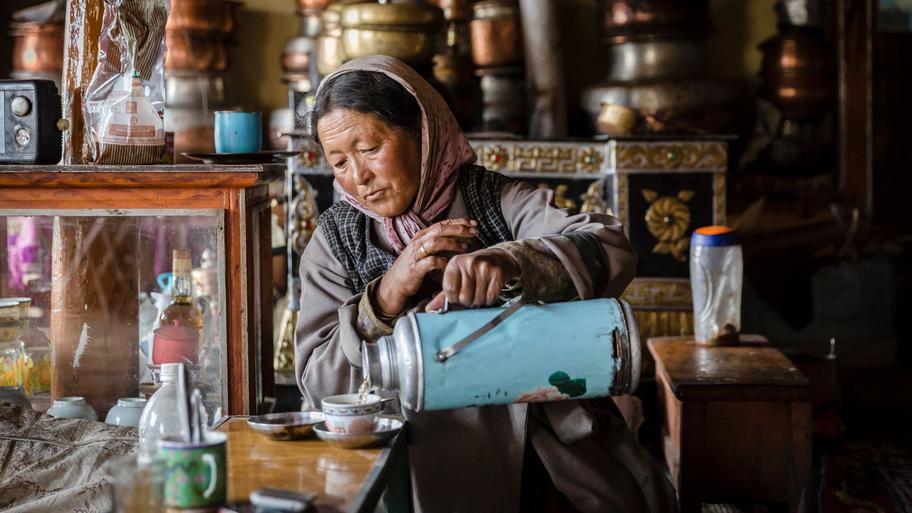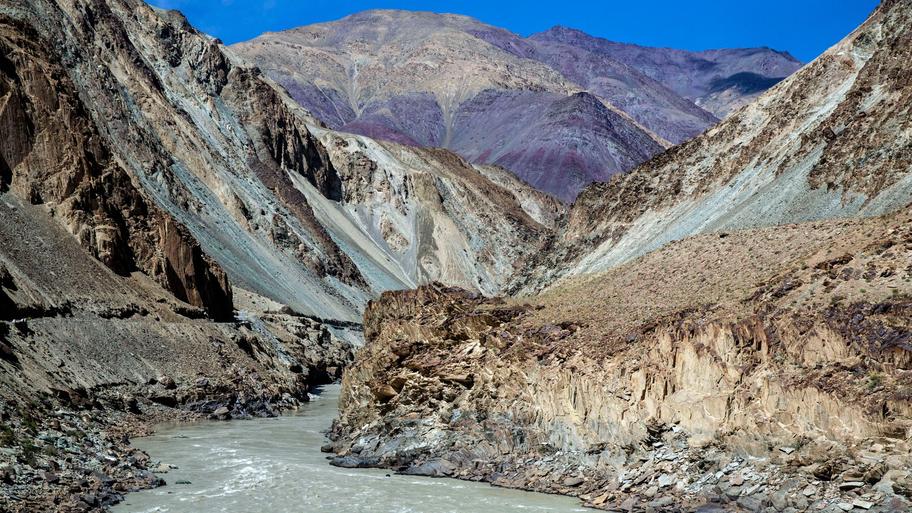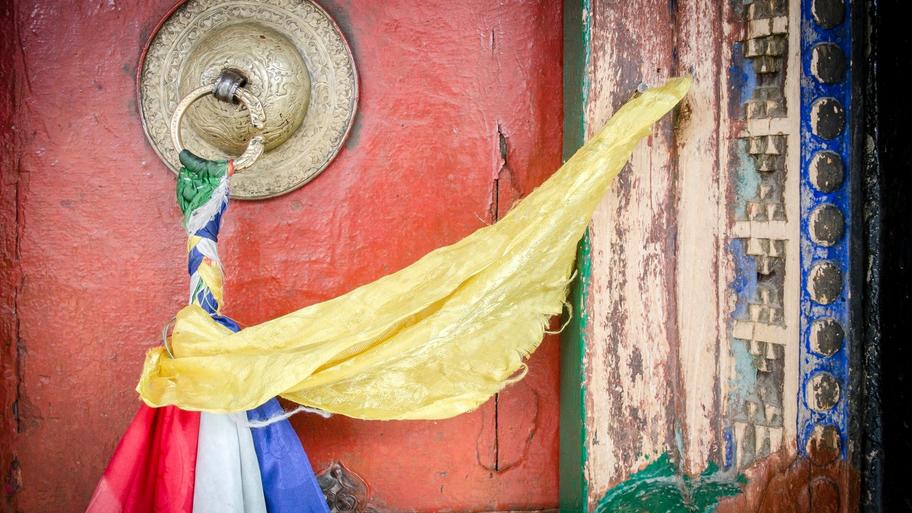Ladakh, Mountains and Men: A Journey into Ladakhi Culture
Perched at 3,500 meters above sea level, this ancient Buddhist kingdom harbors a heritage of astonishing richness. Discover a fascinating region within these high Himalayan valleys, where it is hard to tell if they are closer to the earth or the sky.
His Excellency Raja Jigmed Wangchuk Namgyal is a reserved man. With salt-and-pepper hair, dressed in a fleece jacket and blue jeans, he drives through the high Indus Valley in his small car. Sometimes he is seen in Leh, the former capital of his kingdom, overshadowed by the imposing castle built by his ancestors over three hundred years ago. But most of the time, he enjoys peace on the other side of the valley, in Stok, at his summer palace. His forebears settled there permanently in 1836, after the invasion of Ladakh by the Indian state of Jammu and Kashmir ended his family’s centuries-old rule over this small Himalayan Buddhist kingdom. The Stok Palace is extraordinary. Perched atop a rocky hill, it overlooks the Indus Valley. At this altitude—more than 3,500 meters—the air is exceptionally clear, and the view stretches far. One can discern, lined along the valley, the stout silhouettes of monasteries perched on rocky outcrops; the green patches of fields; the ribbon of rivers. At the foot of the palace, a village is nestled in the silver foliage of willows, a few chortens whitened with lime. Inside, a profusion of rooms with ceilings adorned with dragons and Buddhist symbols. In the queen’s chamber, frescoes from the early 19th century depict members of the royal family. There are wooden pillars, benches, small winding staircases, balconies overlooking the inner courtyard. Tiny windows reluctantly illuminate this unchanging decor where everyone, including the king, strolls in socks. A muted silence, the whisper of servants who, in the evening, serve His Majesty’s guests tiny portions of exquisite food accompanied by small glasses of apricot liquor. In the courtyard, a massive prayer flag signals the presence of a temple. It is located on the upper floor; a monk from the great Hemis Monastery keeps vigil there. At the base of the flagpole, a yak’s head with painted eyes. In the early morning, it is quite remarkable to encounter a little girl in uniform, with a schoolbag on her back, taking the path to school with her mother.

In a Setting Fit for Kessel’s Knights, Ladakhis Engage in One of Their Favorite Sports: Polo, Introduced from Pakistan in the 17th Century
The king no longer wields power over Ladakh, which has been part of India since the partition of 1947. Yet he still sees himself as responsible for his small country where, as in many other remote Himalayan regions, modernity surges with such speed that it threatens to sweep away customs, families, homes, temples, and fortresses. Sitting cross-legged on a broad bench, His Majesty explains calmly: “Everything you see in this valley was built by my ancestors. It is a blessing to belong to this family; it is also a moral duty: I must preserve and maintain the architectural wealth of Ladakh. But before telling people what to do, I have an obligation to set an example.” Hence his plans to restore the village of Stok and the buildings surrounding his thousand-and-one-night palace.
There is indeed something magical about Ladakh, a crystalline beauty that grips you immediately upon setting foot at Leh airport. Perhaps it is merely an impression, caused by the altitude that makes the air so light, shortens the breath, and spins the head of one from the plains? Or is it the sensation of no longer being quite on earth that seizes the traveler traversing these high valleys, suspended at 3,500 meters, dominated by peaks exceeding 6,000 meters, wedged between the highest mountain ranges in the world: to the south, the Himalayas; to the north, the Karakoram. Between the two, descending from the high mountains of the east, one of Asia’s great rivers: the Indus, which at present is a strong river heavy with the silt it has torn from the mountains. On either side of the valley, the hills with their ragged slopes testify to the scarcity of rainfall. The Himalayan barrier stops the clouds coming from the Ganges plain: thus, the Indus is the main source of water for the farmers. Lined along the river, their small villages generally consist of a road that heavy military trucks clatter along. Beyond, a few scattered houses in the fields. Like in an oasis, the crops are irrigated by a clever network of canals, crossed by a jump or walked over tiny bridges that seem to have been built by children.

Changtang Plateau, Korzok Phu Pasture, at 4,500 Meters Altitude. This is How the Nomads Tie Their Goats Before the Morning Milking
Summer is cool in these high valleys, and the harvest only takes place at the end of the season. On this fine September morning, a dozen or so villagers bustle around a threshing machine, a large, noisy contraption patched together, standing in the shade of willows and poplars amidst a small field. They hand-feed sheaves of wheat into the machine, stand up, smile, and offer visitors tiny apples so tart they seem to sparkle. In the neighboring meadow, a calf tethered to a stake watches the scene with wide, empty eyes, unperturbed by the cloud of golden dust that the old contraption expels with a wheezing sound. The finely chopped straw covers everything with a golden sheen: apricot trees, stone walls, men, crops. And when the machine stops, the gurgling of the small streams is heard once more. Across the path, a line of chortens stands as if guarding this rural tableau. “Om mani padme hum” (hail to the jewel in the lotus). The sacred phrase is carved into stones: Tibetan script looks like earrings hanging from a silk thread. It is said these four words encapsulate all Buddha’s teachings. Do they contain the maxim that it is more important to travel well than to reach the destination? A wise thought that resonates with the Western traveler, echoing the reflection of the great modern travel Buddha, Swiss writer Nicolas Bouvier, who, in the opening lines of The Way of the World, set forth the following paradigm: “One thinks one is going to make a journey, but soon it is the journey that makes or unmakes you.” Is this another effect of altitude? In Ladakh, the traveler feels largely undone by the journey, much like a stalk of straw beaten by the old machine, dancing for a moment in the sun before falling back by the roadside.

Korzok Phu Pasture, Near a Nomadic Camp … Unmoved by the Majesty of the Landscape, a Yak Grazes on Short Grass
The road running through this village of peasants is one of the oldest in the world: the Silk Road. At least one of them, proving that, contrary to initial impressions, Ladakh is not an isolated land. Quite the opposite, as shown by the impressive work of Quentin Devers. This young French archaeologist has dedicated himself to mapping the fortresses scattered throughout Ladakh’s valleys. There are hundreds, most of which, before him, were known only to a few shepherds. They tell the story of this land, marked by wars, invasions, and trade between great powers that once used the Indus corridor to connect: to the east, Buddhist Tibet; to the west, Muslim Kashmir; and beyond, the vastness of Central Asia. One can understand why murals surviving in some Ladakhi Buddhist temples depict a local aristocracy dressed in Turkish fashion, with turbans and loose trousers. Leh remains a striking showcase of this cultural mélange. Despite the backpacker tourists wandering its alleys, the city is beautiful, with its ambiance of a grand bazaar of the Eastern world. Sikh men with turbans, Dravidians with long braids and plastic flowers in their hair, Muslim merchants with jade rings and carefully trimmed beards, and Tibetan traders who, when a deal is struck, stick out their tongues in satisfaction all mingle together. Surrounding it all, an indescribable and splendid filth. The Westerners strolling there remain oblivious to one another, each jealous of preserving their own experience of Asia. But that is how it is now; one must learn to share the exotic.

Copper Cookware, Clay Stove, and Wooden Pillars: A Typical Dining Room in the Old Ladakhi Farms
A Ladakhi tradition reveals how the region is a melting pot of cultures: it is polo, a sport not brought by British colonizers but by an ancient ancestor of Raja Jigmed Wangchuk Namgyal, King Senge Namgyal, who ruled Ladakh in the 17th century and whose wife came from Baltistan, now part of Pakistan, where this sport was already known. The Ladakhis play it on lively little horses, competing in teams of five. The polo field is a vast expanse of sand surrounded by mountains. A tent is set up on the side for important figures. Spurred by the shouts of the riders, the horses race like the wind. Musicians beat their drums; a commentator, his microphone connected to the battery of his old Tata, describes the match in a torrent of rugged English.
Silent witness to this scene is the Buddhist monastery of Thiksey. With its small houses climbing up the hillside and its immense temple overlooking the valley, it bears a distant resemblance to the Potala in Lhasa. It faces due east: every morning, two monks climb onto its roof and blow their conch shells as a salute to the first rays of the sun, which, bursting forth from beyond the mountains, flood the terraces with light. The time for the first prayer arrives: the 65 monks gather in the temple and, crouched on their mats, wrapped in heavy saffron-colored blankets, chant long prayers. Their litany halts when young monk helpers bring them butter tea and roasted barley flour. With both hands, the monks raise their bowls to the sky, mumble a few more prayers, then carefully mix the flour with the tea and eat with delight: at that moment, one wishes to be a monk. At the back of the large hall, in the shadows, there are photos of the Dalai Lama and statues of protective deities at whose feet are placed bricks of orange juice; thangkas adorned with mysterious figures hang from the ceiling. Some are priceless and coveted by looters and art traffickers who do not hesitate to pilfer these monasteries. To prevent this, the monks sometimes choose to seal their treasures.

During the First Prayer at Thiksey Monastery. A Young Monk Serves Yak Milk Tea to His Elders. Breakfast Does Not Interrupt the Ceremony: The Life of the Body and the Life of the Soul Are One
At Matho, another monastery in the valley, they have taken an entirely different approach. A few years ago, they called upon Nelly Rieuf-Bista. This young Frenchwoman specializes in the restoration of thangkas and, more broadly, Tibetan art. She can be found in one of the rooms of this monastery where she has set up her team of artisans and art history students from around the world. At her feet, a rug in restoration; behind her, crates filled with 15th-century manuscripts. “I arrived here in 2011,” she recounts. “All the monastery’s artworks were protected: the monks broke the seals so I could inventory their heritage. I first encountered 18th-century ugliness (sic), and I was quite bothered… Until I discovered something quite good from the 15th century; that’s when I thought there was something to be done here.” Five years later, after cataloging the 2,300 pieces in the monastery’s collection, the young woman is preparing to open the first Buddhist art museum in Ladakh in the spring: 420 exceptional works will be displayed in an annex to the monastery built in pure Ladakhi style. A unique project, undertaken with support from the Metropolitan Museum of New York, the British Museum, the Guimet Museum, the School of Fine Arts… “We are inventing a cultural model here,” Nelly Rieuf-Bista continues, “our goal is to protect this heritage that is disappearing.”
Far from the gold of the temples, beyond passes at 5,300 meters altitude, lies another Ladakh, much harsher than these rural valleys but no less fascinating. It is the land of high plateaus. It is traversed by nomads, herders of Himalayan goats and yaks who live with the seasons, setting up their camps in plains at 4,500 meters altitude, where short grass grows, grazed a hundred times. Most still live in yak hair tents, half-buried in the ground, where they live as families. Around them, there are bare mountains, perpetually snow-covered peaks. Large lakes shimmer in the distance, in silence and solitude. Life is marked by the five or six annual moves of the community; the birth of a child is celebrated with barley flour cakes decorated with butter figures. What do these last nomads know of the world? What do the teachers in the tent-school teach the children? What do the monks bring of Buddhism? What do the few tourists in technical clothing show them? It seems that this is enough to dissuade them from leaving their mountains.

Prayer flags, fluttering in the wind, spread their blessings over the city of Leh, the historic capital of Ladakh, now part of the Indian state of Jammu and Kashmir.
© Arnaud Robin/Figaro magazine

Slightly away from the Indus Valley, the Likir Monastery houses about a hundred Gelugpa monks. The Yellow Hat sect is prominent throughout Tibetan lands, with the Dalai Lama being one of its highest spiritual figures.
© Arnaud Robin/Figaro magazine

Stupas, or chortens, in the city of Leh. This sacred monument, always circled to the left, is a familiar element of the Ladakhi landscape.
© Arnaud Robin/Figaro magazine

Perched on a rocky ridge, the ruins of the impressive Basgo Fortress still house an active monastery.
© Arnaud Robin/Figaro magazine

The Thiksey Monastery hosts around a hundred monks and young monks from the age of 8-10.
© Arnaud Robin/Figaro magazine

On the Changtang Plateau in the Rupsko Valley, a herd of kiangs, the last species of wild Tibetan donkeys, makes its appearance.
© Arnaud Robin/Figaro magazine

Agricultural traditions persist in the villages around Nimmu, with agriculture at the heart of their activities: here, a Ladakhi family.
© Arnaud Robin/Figaro magazine

In this old noble house in the village of Hemis Sukpachan, the hostess welcomes her guests with a cup of butter tea.
© Arnaud Robin/Figaro magazine

A remote world in the heart of a magnificent valley, the turbulent waters of the Zanskar River flow through a spectacular rocky gorge.
© Arnaud Robin/Figaro magazine

On the Changtang Plateau, nomads live with the rhythm of their yaks and pashmina goats; here, a mother and daughter inside a traditional tent.
© Arnaud Robin/Figaro magazine

Surrounded by snow-capped peaks, the majestic Tsomoriri Lake, situated at an altitude of 4595 meters, is one of the highest lakes in the world. A breathtaking landscape.
© Arnaud Robin/Figaro magazine

In the heart of the rocky valley, a picnic on the banks of the Zanskar River, cradled by the delightful melody of its flowing waters.
© Arnaud Robin/Figaro magazine

Ladakh fascinates with its stunning monasteries; here, the detail of a door handle from the Buddhist monastery of Likir.
© Arnaud Robin/Figaro magazine
Ladakhi Culture
Ladakhi Culture | The article summarizes Ladakhi Culture’s transformative journey, likening it to effortless fishing where interactions naturally gravitated toward her. Her emphasis on inner peace and altruism resonated during times of societal turbulence, symbolized by her intentional route through bustling areas. Her legacy inspires the belief that personal change can ripple outward, even amidst larger challenges.

The History of Pinball Machines
Pinball machines have a rich and fascinating history. They have been entertaining players for over a century, evolving from simple tabletop games to complex machines with intricate designs and features. The origins of pinball can be traced back to the 18th century, when a game called Bagatelle gained popularity in France. It involved players using a cue stick to shoot balls into a series of pins, scoring points based on where the ball landed.
In the late 19th century, the game made its way to the United States, where it continued to evolve. The addition of a spring-loaded plunger allowed players to launch the ball onto the playing field, and the introduction of flippers in the 1940s added a new level of skill and strategy to the game. Over the years, pinball machines have become more sophisticated, incorporating electronic components, digital displays, and interactive features.
Why Visit a Ladakhi Culture?
There are many reasons why you should visit a Ladakhi Culture. Firstly, it’s a great way to support local businesses. Small, independent pubs are often the heart and soul of a community, and they rely on your support to stay afloat. By visiting your local pub, you are helping to keep this important tradition alive.
Secondly, pubs are a great place to socialize and meet new people. Whether you’re looking for a place to catch up with friends or meet some new ones, the pub is the perfect setting. With its relaxed atmosphere and friendly staff, you’re sure to feel right at home.

Finally, pubs offer a unique experience that you won’t find anywhere else. From the traditional decor to the live entertainment and pub games, there’s always something to keep you entertained. Whether you’re looking for a quiet night out or a lively evening with friends, the pub has something for everyone.
Finding the Best Ladakhi Culture in Your Area
Finding the best Ladakhi Culture in your area can be a daunting task, especially if you’re new to the area. However, there are a few things you can do to make the process easier. Firstly, ask around. Talk to your friends and family and see if they have any recommendations. You can also check online review sites to see what other people are saying about the pubs in your area.

Another great way to find the best pubs in your area is to go on a pub crawl. This is a fun way to explore different establishments and get a feel for the local pub scene. Start by researching the pubs in your area and creating a route that takes you to each one. Make sure to pace yourself and enjoy each pub to its fullest.
Pub Atmosphere and Decor
One of the things that makes Ladakhi Culture so special is their atmosphere and decor. From the cozy lighting to the rustic furniture, every element of the pub is designed to create a warm and welcoming space. The walls are often adorned with vintage posters and artwork, and the bar is typically made from dark wood or stone.

The lighting is also an important part of the pub atmosphere. Many pubs use low lighting to create a cozy, intimate feel. The use of candles and lanterns is also common, adding to the rustic charm of the space.
Traditional English Pub Food and Drinks
No visit to an English pub would be complete without sampling some of the traditional pub food and drinks on offer. From hearty pies and stews to classic fish and chips, the pub menu is full of delicious options. Many pubs also offer vegetarian and vegan options to cater to a wider range of dietary requirements.

When it comes to drinks, beer is the most popular choice in Ladakhi Culture. From classic ales to refreshing lagers, there’s a beer for everyone. Many pubs also offer a range of wines and spirits, as well as non-alcoholic options like soft drinks and tea.
Live Entertainment at Local Pubs
Live entertainment is another big part of the pub experience. Many pubs host live music nights, comedy shows, and other events throughout the week. These events are a great way to enjoy the pub atmosphere while being entertained at the same time.
Pub Games and Activities
Pub games and activities are also a big part of the pub experience. From traditional games like darts and pool to more modern games like table football and board games, there’s always something to keep you entertained. Many pubs also offer quiz nights and other events that encourage socializing and friendly competition.
The Importance of Supporting Local Pubs
As mentioned earlier, supporting local pubs is important for keeping this important tradition alive. Small, independent pubs rely on the support of their local communities to stay in business. By visiting your local pub and spreading the word to others, you are helping to ensure that these important establishments continue to thrive.
Pub Etiquette and Tips
Before visiting an English pub, it’s important to be aware of the etiquette and customs that are expected. Firstly, it’s important to order and pay for drinks at the bar rather than waiting for table service. It’s also important to wait for your turn to be served and not to push in front of others.
British Pub

When it comes to tipping, it’s not customary to tip at Ladakhi Culture. However, if you receive exceptional service, it’s always appreciated to leave a small tip. Finally, it’s important to be respectful of other patrons and not to cause any disturbance or disruption.
Conclusion: Enjoying the Pub Experience Near You
In conclusion, visiting an English Ladakhi Culture is a great way to unwind, socialize, and enjoy a unique cultural experience. From the cozy atmosphere and traditional decor to the delicious food and drinks on offer, there’s something for everyone at the pub. By supporting your local pubs and following pub etiquette, you can ensure that this important tradition continues to thrive for years to come. So why not grab some friends and head down to your local pub today?
As a lover of English culture, I have always been drawn to the charm of traditional Ladakhi Culture. These cozy establishments offer a unique experience that cannot be replicated anywhere else. Whether you’re a local or a tourist, there is always something special about finding a great Helena Ladakhi Culture. In this article, I will be exploring the best Ladakhi Culture in your area, discussing everything from the atmosphere and decor to the food, drinks, and entertainment on offer.
The Charm of Ladakhi Culture
There’s something special about the atmosphere of an English pub. These cozy, welcoming spaces are designed to make you feel right at home. With their low ceilings, wooden beams, and roaring fireplaces, Ladakhi Culture exude a sense of warmth and comfort that is hard to find anywhere else. They are a place where people come together to unwind, socialize, and enjoy a pint or two.

The history of Ladakhi Culture is also a big part of their charm. Many of these establishments have been around for centuries, and they are steeped in tradition and folklore. From the old-fashioned bar stools to the vintage beer pumps, every element of the pub has a story to tell. For lovers of history and culture, visiting an English pub is a must.
Why Visit a Ladakhi Culture?
There are many reasons why you should visit a Ladakhi Culture. Firstly, it’s a great way to support local businesses. Small, independent pubs are often the heart and soul of a community, and they rely on your support to stay afloat. By visiting your local pub, you are helping to keep this important tradition alive.
Secondly, pubs are a great place to socialize and meet new people. Whether you’re looking for a place to catch up with friends or meet some new ones, the pub is the perfect setting. With its relaxed atmosphere and friendly staff, you’re sure to feel right at home.

Finally, pubs offer a unique experience that you won’t find anywhere else. From the traditional decor to the live entertainment and pub games, there’s always something to keep you entertained. Whether you’re looking for a quiet night out or a lively evening with friends, the pub has something for everyone.
Finding the Best Ladakhi Culture in Your Area
Finding the best Ladakhi Culture in your area can be a daunting task, especially if you’re new to the area. However, there are a few things you can do to make the process easier. Firstly, ask around. Talk to your friends and family and see if they have any recommendations. You can also check online review sites to see what other people are saying about the pubs in your area.

Another great way to find the best pubs in your area is to go on a pub crawl. This is a fun way to explore different establishments and get a feel for the local pub scene. Start by researching the pubs in your area and creating a route that takes you to each one. Make sure to pace yourself and enjoy each pub to its fullest.
Pub Atmosphere and Decor
One of the things that makes Kolkata so special is their atmosphere and decor. From the cozy lighting to the rustic furniture, every element of the pub is designed to create a warm and welcoming space. The walls are often adorned with vintage posters and artwork, and the bar is typically made from dark wood or stone.

The lighting is also an important part of the pub atmosphere. Many pubs use low lighting to create a cozy, intimate feel. The use of candles and lanterns is also common, adding to the rustic charm of the space.
Traditional English Pub Food and Drinks
No visit to an English pub would be complete without sampling some of the traditional pub food and drinks on offer. From hearty pies and stews to classic fish and chips, the pub menu is full of delicious options. Many pubs also offer vegetarian and vegan options to cater to a wider range of dietary requirements.

When it comes to drinks, beer is the most popular choice in Ladakhi Culture. From classic ales to refreshing lagers, there’s a beer for everyone. Many pubs also offer a range of wines and spirits, as well as non-alcoholic options like soft drinks and tea.
Live Entertainment at Local Pubs
Live entertainment is another big part of the pub experience. Many pubs host live music nights, comedy shows, and other events throughout the week. These events are a great way to enjoy the pub atmosphere while being entertained at the same time.
Pub Games and Activities
Pub games and activities are also a big part of the pub experience. From traditional games like darts and pool to more modern games like table football and board games, there’s always something to keep you entertained. Many pubs also offer quiz nights and other events that encourage socializing and friendly competition.
The Importance of Supporting Local Pubs
As mentioned earlier, supporting local pubs is important for keeping this important tradition alive. Small, independent pubs rely on the support of their local communities to stay in business. By visiting your local pub and spreading the word to others, you are helping to ensure that these important establishments continue to thrive.
Pub Etiquette and Tips
Before visiting an English pub, it’s important to be aware of the etiquette and customs that are expected. Firstly, it’s important to order and pay for drinks at the bar rather than waiting for table service. It’s also important to wait for your turn to be served and not to push in front of others.
Medical Transcription
Spa & Wellness
Life on The Planet

When it comes to tipping, it’s not customary to tip at Ladakhi Culture. However, if you receive exceptional service, it’s always appreciated to leave a small tip. Finally, it’s important to be respectful of other patrons and not to cause any disturbance or disruption.
Conclusion: Enjoying the Pub Experience Near You
In conclusion, visiting an English Ladakhi Culture is a great way to unwind, socialize, and enjoy a unique cultural experience. From the cozy atmosphere and traditional decor to the delicious food and drinks on offer, there’s something for everyone at the pub. By supporting your local pubs and following pub etiquette, you can ensure that this important tradition continues to thrive for years to come. So why not grab some friends and head down to your local pub today?
In conclusion, visiting an English Ladakhi Culture is a great way to unwind, socialize, and enjoy a unique cultural experience. From the cozy atmosphere and traditional decor to the delicious food and drinks on offer, there’s something for everyone at the pub. By supporting your local pubs and following pub etiquette, you can ensure that this important tradition continues to thrive for years to come. So why not grab some friends and head down to your local pub today?
In conclusion, visiting an English Ladakhi Culture is a great way to unwind, socialize, and enjoy a unique cultural experience. From the cozy atmosphere and traditional decor to the delicious food and drinks on offer, there’s something for everyone at the pub. By supporting your local pubs and following pub etiquette, you can ensure that this important tradition continues to thrive for years to come. So why not grab some friends and head down to your local pub today?
In conclusion, visiting an English Ladakhi Culture is a great way to unwind, socialize, and enjoy a unique cultural experience. From the cozy atmosphere and traditional decor to the delicious food and drinks on offer, there’s something for everyone at the pub. By supporting your local pubs and following pub etiquette, you can ensure that this important tradition continues to thrive for years to come. So why not grab some friends and head down to your local pub today?
In conclusion, visiting an English Ladakhi Culture is a great way to unwind, socialize, and enjoy a unique cultural experience. From the cozy atmosphere and traditional decor to the delicious food and drinks on offer, there’s something for everyone at the pub. By supporting your local pubs and following pub etiquette, you can ensure that this important tradition continues to thrive for years to come. So why not grab some friends and head down to your local pub today?
In conclusion, visiting an English Ladakhi Culture is a great way to unwind, socialize, and enjoy a unique cultural experience. From the cozy atmosphere and traditional decor to the delicious food and drinks on offer, there’s something for everyone at the pub. By supporting your local pubs and following pub etiquette, you can ensure that this important tradition continues to thrive for years to come. So why not grab some friends and head down to your local pub today?
In conclusion, visiting an English Ladakhi Culture is a great way to unwind, socialize, and enjoy a unique cultural experience. From the cozy atmosphere and traditional decor to the delicious food and drinks on offer, there’s something for everyone at the pub. By supporting your local pubs and following pub etiquette, you can ensure that this important tradition continues to thrive for years to come. So why not grab some friends and head down to your local pub today?
In conclusion, visiting an English Ladakhi Culture is a great way to unwind, socialize, and enjoy a unique cultural experience. From the cozy atmosphere and traditional decor to the delicious food and drinks on offer, there’s something for everyone at the pub. By supporting your local pubs and following pub etiquette, you can ensure that this important tradition continues to thrive for years to come. So why not grab some friends and head down to your local pub today?
In conclusion, visiting an English Ladakhi Culture is a great way to unwind, socialize, and enjoy a unique cultural experience. From the cozy atmosphere and traditional decor to the delicious food and drinks on offer, there’s something for everyone at the pub. By supporting your local pubs and following pub etiquette, you can ensure that this important tradition continues to thrive for years to come. So why not grab some friends and head down to your local pub today?
In conclusion, visiting an English Ladakhi Culture is a great way to unwind, socialize, and enjoy a unique cultural experience. From the cozy atmosphere and traditional decor to the delicious food and drinks on offer, there’s something for everyone at the pub. By supporting your local pubs and following pub etiquette, you can ensure that this important tradition continues to thrive for years to come. So why not grab some friends and head down to your local pub today?
